Did you know that even if you don’t have lots of sunlight coming through your windows, you can still grow lush plants indoors?
Yes, foliage has had a place in dim corners of stylish homes since Victorian days, livening up the decor and even helping to reduce stress levels.
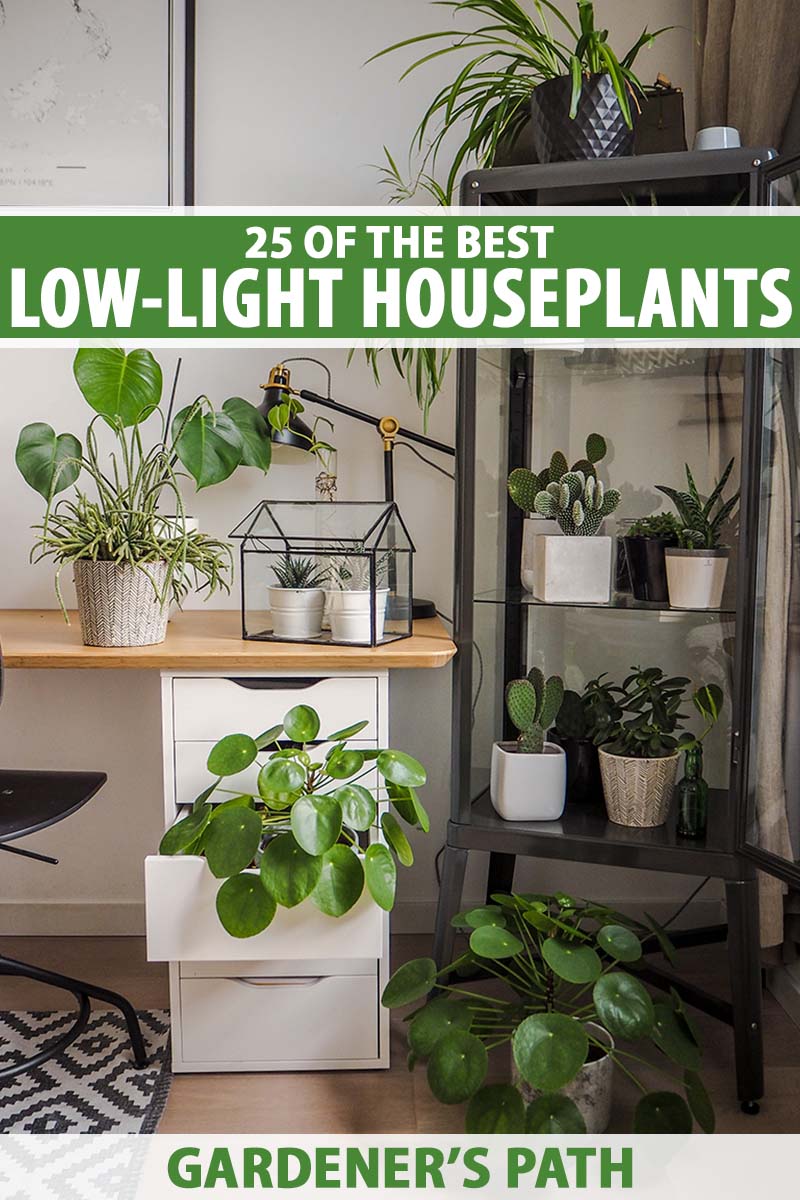
We link to vendors to help you find relevant products. If you buy from one of our links, we may earn a commission.
Recent studies have shown that time spent in green spaces helps to alleviate anxiety and support healthy cognitive functioning as well.
If you have low-light areas in your home that could benefit from a touch of greenery, keep reading to discover 25 of our low-light favorites and where to buy them.
Here’s the lineup:
25 Houseplant Options for Low-Light Areas
When I kept a golden pothos on an end table in my north-facing living room, it had dark green leaves.
Since moving it to my sunny kitchen, the leaves have become variegated with green/yellow and white/yellow markings. This is what we mean when we say that a houseplant will “tolerate” low light.
Don Janssen, extension educator at the Lancaster County Extension of the University of Nebraska-Lincoln Institute of Agriculture and Natural Resources defines low light areas as those that “receive enough light to read by during the day and are typically found within a few feet of a window.”
Grown in dim areas of the home and away from windows, they will add attractive foliage to enhance your decor.
Though many species will grow more slowly than they might if given more light, and they will not produce flowers, that’s no reason to skip adding houseplants to these spaces altogether!

The following five traits are common to all plants described here:
1. The darkest green varieties perform the best in low-light conditions.
2. Watering needs are greatest during the growing season and lower in the winter months.
3. Fruits and flowers seldom appear with indoor cultivation under low-light conditions.
4. These options are not prone to pests and diseases, provided you use a pot with adequate drainage and don’t over- or under-water. Common houseplant pests like mealybugs, scale, and spider mites may require treatment.
Most are easily removed with 70-percent isopropyl rubbing alcohol on a cotton ball, or an application of organic insecticidal neem oil like this concentrated product, available from Arbico Organics.
5. Those described in this list may be propagated by division or by rooting stem cuttings, so you can add to your collection.
For each entry below, we’ll note whether the subject plant is deemed toxic or nontoxic, as per the ASPCA. They are all ornamental and not intended for ingestion by pets or people.
Let’s get started – there are so many to love, but we’ve narrowed the choices down for you with the best picks!
1. Aluminum Plant
The silvery accents on the green leaves of the aluminum plant (Pilea cadierei) can be used to highlight the metallic and reflective aspects of your entertaining spaces, such as chrome table legs and art frames, glass surfaces, and vases.
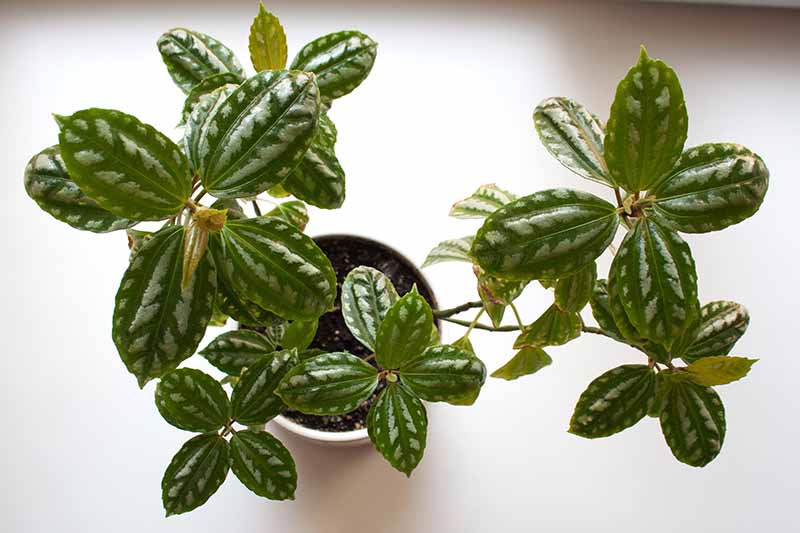
This tabletop lovely tops out at 12 inches tall. Use a soil-based potting mixture and increase the humidity around it by misting occasionally or setting your pot on a bed of wet pebbles.
Occasionally pinching off the first pair or two of leaves just above the next pair down helps to maintain a compact shape. The ideal room temperature for this houseplant is 60 to 75°F with 70 percent humidity.

Feed monthly during the spring and summer with an all-purpose liquid or slow-release granular product per package instructions.
Aluminum plants in 2.5-inch pots are available from Hirt’s Gardens via Amazon. It is nontoxic to pets.
Learn all you need to know about growing aluminum plants here.
2. Arrowhead Plant
You can choose from dwarf 12-inch types for your smaller spaces or full-sized behemoths that top out at six feet tall if you like the looks of the arrowhead vine.
Place one on the coffee table, or train two up moss poles in stylish urns on either side of your front door in the foyer.
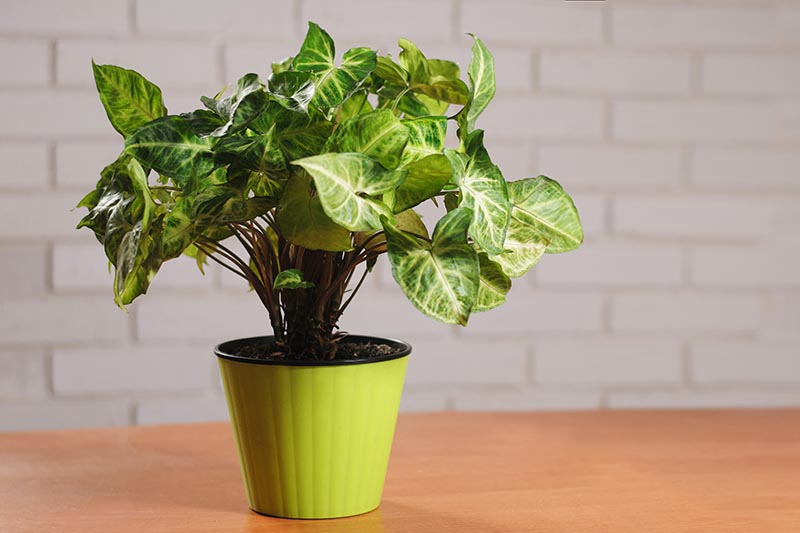
An interesting characteristic of Syngonium podophyllum is that as the leaves mature, they become longer and more arrowhead-shaped, hence the name.
Provide a porous potting mixture and ample humidity via misting for best results. Otherwise, they are known for being very resilient.
Locate them in a temperate room in the 60 to 85°F range with 50 percent humidity. Place the pot on a bed of moist stones, group plants, or use a humidifier if necessary to increase ambient moisture.
Don’t mist those growing in very dim areas, as this may increase the risk of fungal growth.
Fertilize monthly with liquid or granular fertilizer per product directions.
‘White Butterfly’ is a popular cultivar that features broad leaves in pale green with darker green edges.
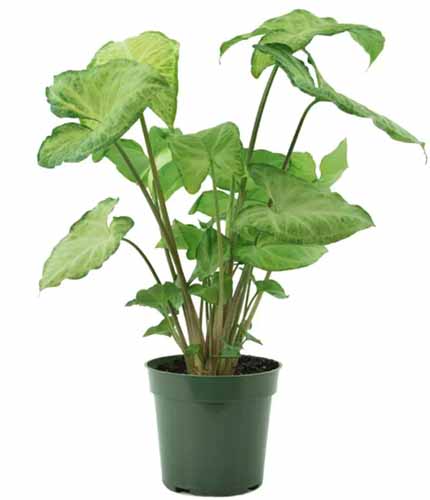
You can find ‘White Butterfly’ in four-inch pots available as a three-pack via Home Depot. It is toxic to pets.
Read more about growing arrowhead plants here.
3. Artillery Plant
With such a powerful name, you’d never expect the charming, tiny green leaves and unimposing nature of the artillery plant (Pilea microphylla). Topping out at a mere six to 12 inches, it is a petite pleasure.
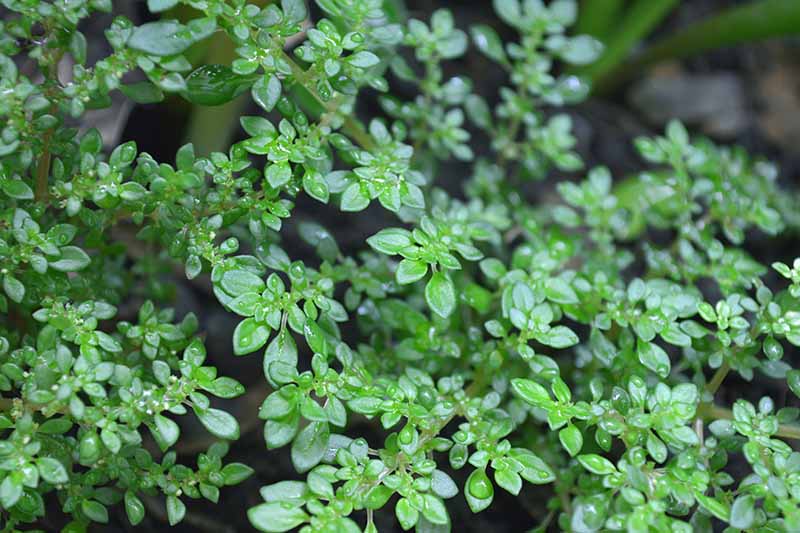
Soften the look of a square-edged end table with a close-cropped pot, enhance cottage charm with a meandering mass on a bookshelf, or place it in a pot underneath taller specimens to add texture and interest.
Fertilize sparingly with liquid or granular houseplant food, once in spring and again in summer.
Artillery plants are available in three-inch pots from Winter Greenhouse via Walmart. It is nontoxic to pets.
Read our guide to learn more about growing your own artillery plants.
4. Broadleaf Lady Palm
Lady palm (Rhapis excelsa) is another showstopper, with a mature height of about six feet.
Slender, woody stalks topped with fan-like, spiky leaf fronds rustle softly when you brush past. It’s the perfect textural accompaniment to sleek interiors furnished in leather.
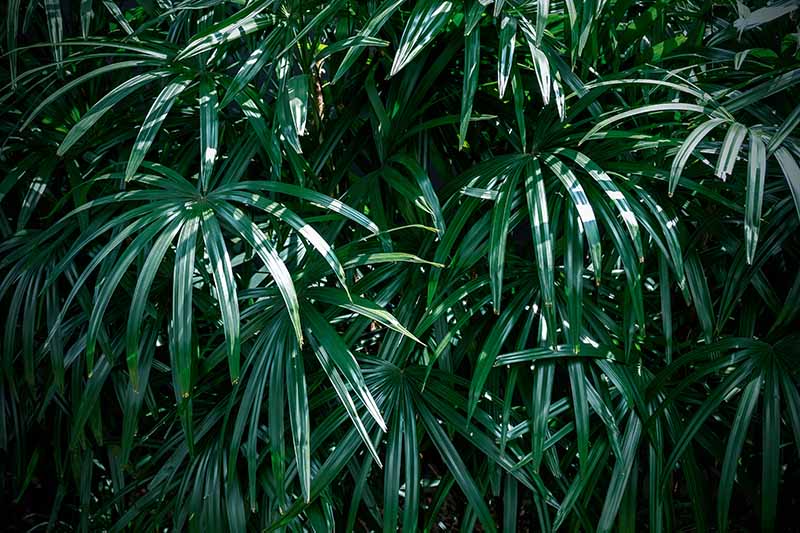
And while those grown indoors seldom bloom, you may be rewarded with small white blossoms and white ornamental fruits.
With a temperate indoor climate, moderate humidity, organically-rich potting medium, and even moisture, your lady palm will thrive for many years to come.
Maintain even moisture during the growing season. In winter, you can let the top inch of soil dry out before watering.
Fertilize sparingly to avoid burning. Use half-strength houseplant food once a year in spring or summer.
Diseases and pests to watch for with this species include aphids, leaf spot, and scale. Keep them at bay with well-draining pots and avoid under- and over-watering.
Broadleaf lady palm is available from Fast Growing Trees in three-gallon pots. It is nontoxic to pets.
Read all you need to know about broadleaf lady palm here.
5. Calathea Zebra Plant
At an impressive height of up to three feet, the contrasting shades of green that stripe the leaves of the zebra plant (Calathea zebrina) make for a bold indoor focal point.
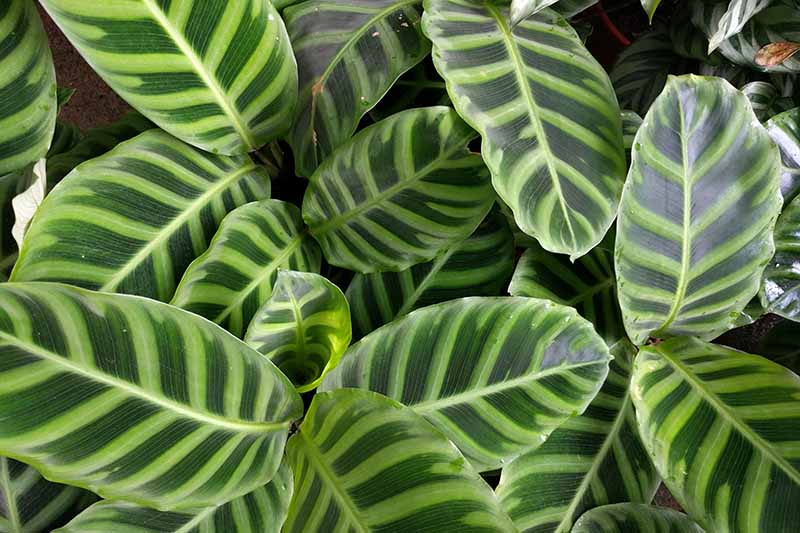
This species is also known as a prayer plant, because its leaves close at dusk and resemble praying hands. Accustomed to tropical climes, it prefers a humid environment that is best achieved by occasionally misting the leaves with a water spritzer bottle.
Pot in organically-rich soil in a container that drains well. Keep it uniformly moist throughout the growing season and ease up a bit during the coldest months of the year when it is dormant.
A root system of rhizomes produces clumps of elongated leaves. Divide every few years to maintain a compact form and create new plants.

Indoor cultivation yields foliage but no flowers. When grown outside in Zones 11 to 12, spring blossoms in shades ranging from white to purple complement the attractive leaves.
Calathea zebrina is available in four-inch pots from via Amazon. It is nontoxic to pets.
Grow your own calathea zebra plant with the instructions in our guide.
6. Cast-Iron Plant
The cast-iron plant (Aspidistra elatior) lives up to its name. The folks at University of Florida Gardening Solutions call it a “bulletproof houseplant… especially suited for homes and offices that don’t receive much light.”
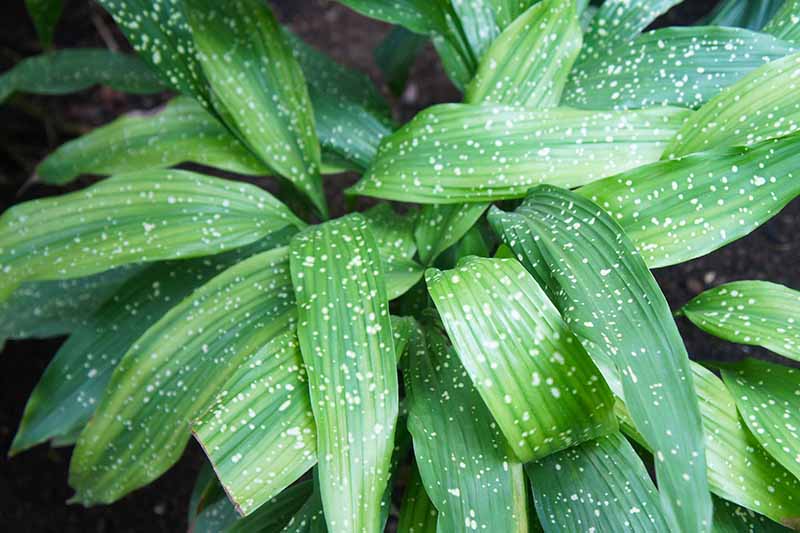
Topping out at two to three feet, the elongated green leaves of the cast-iron plant add a lush, tropical ambiance to even the darkest corners of your home. In fact, direct sunlight is likely to burn its leaves to a crisp.
The cast iron plant grows very slowly from rhizomes, forming dense clumps of foliage. It thrives best in peat potting soil in a container with drainage holes.
Even moisture is best, but too much can rot the roots, so it’s best to let the soil dry completely between watering.
Routine care consists of pruning dead or damaged leaves at the base of the stem, occasionally wiping each leaf with a soft cloth to keep leaves lustrous, and dividing every three years or so to separate clumps and form new plants.
In the spring, you may be treated to a display of small purple flowers and even smaller fruits, but the foliage always takes center stage.
This plant is nontoxic to cats, dogs, and horses (not that you keep them in the house!), and it does not generally require feeding.
Cast iron plant is available from Fast Growing Trees in one- and three-gallon pots.
Looking for growing tips? Our guide can help.
7. Chinese Evergreen
With its glossy, elliptical leaves of variegated green, a potful of slow-growing Chinese evergreen (Aglaonema spp.) is the perfect accent for a dimly lit entry hall.
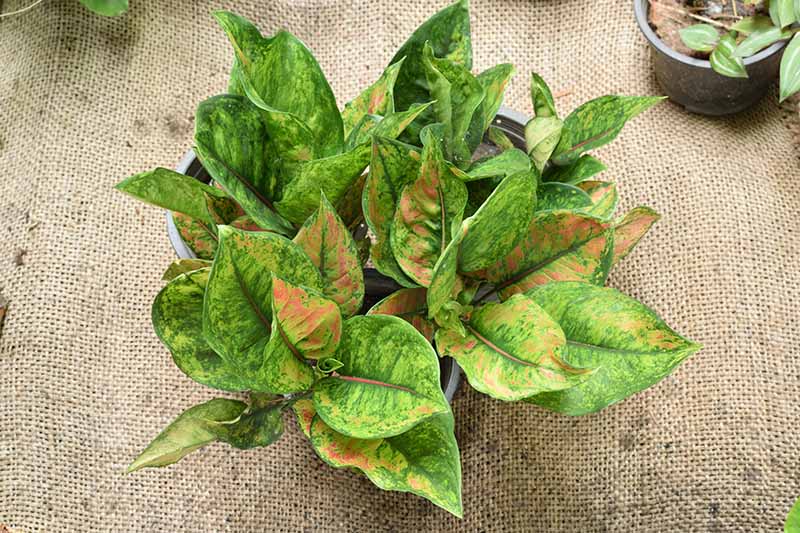
Its shallow roots send up stalks from a central base for compact growth reaching a maximum height of 18 inches.
Chinese evergreen varieties thrive best in an organically-rich, moist potting medium. Humidity is welcome and misting with a spritz bottle can help to maintain optimal conditions in a temperate room.
Fertilize during the growing season, and water just before the pot dries out in low light conditions, or when the top inch or two of soil feels dry in brighter light. Less frequent watering is required in the winter when it goes dormant.
You can easily divide this plant to thin it out or take cuttings to root in water for friends. Some varieties produce nondescript blossoms and berries, but they do not usually appear with indoor cultivation.
There are numerous species, hybrids, and cultivars of Chinese evergreen that may be grown indoors at home, in hues ranging from green to silver and blush pink.
The best options for dim conditions are the greenest in color.
These plants are nontoxic to pets.
‘Maria’ is available from Burpee.
This cultivar has an erect habit and green leaves, and it will grow 14 to 20 inches in height with a spread of 16 to 22 inches.
‘Silver Bay’ is available from Home Depot in nine-inch growers pots. Its leaves exhibit an attractive variegated pattern.
Read about growing your own Chinese evergreen plant here.
8. Dracaena
You’ll find an array of plants under the dracaena (Dracaena spp.) umbrella with tapered narrow leaves that are green, red, yellow, and variegated.
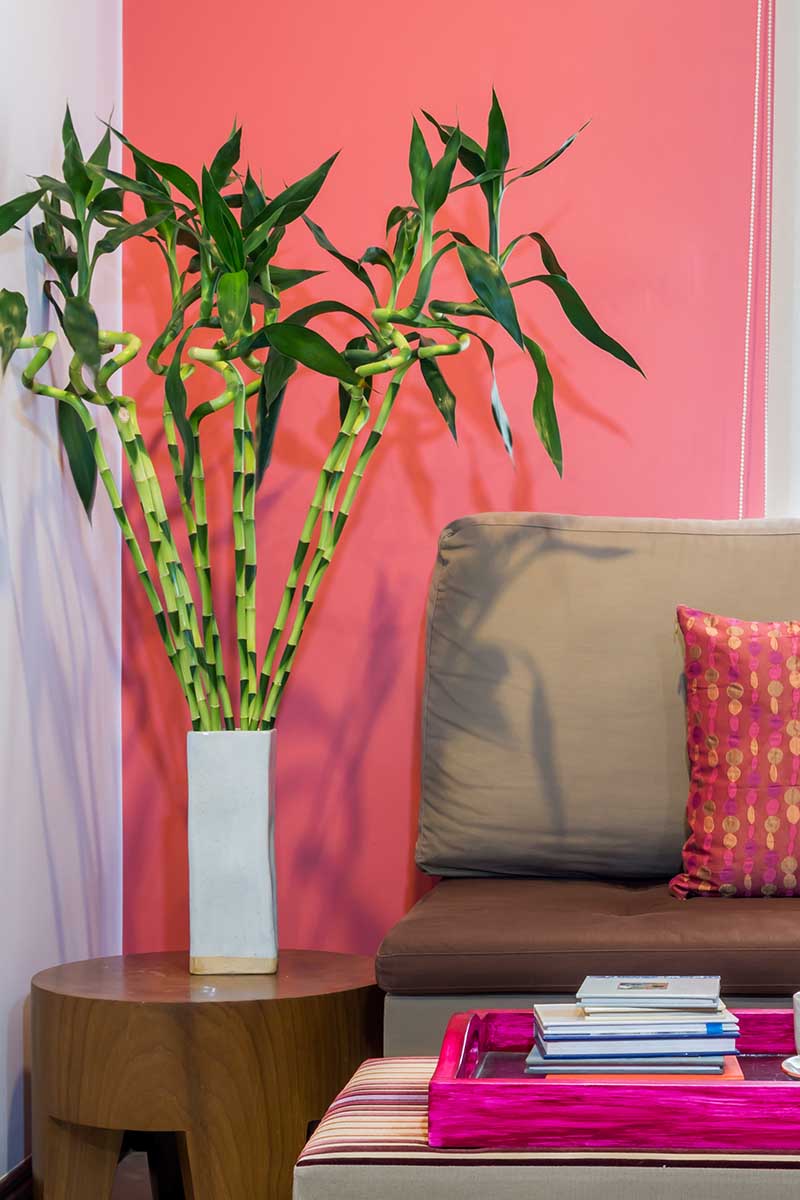
This slow grower likes an organically-rich potting medium that can be achieved with the addition of compost or peat.
Like many houseplants, it prefers bright indirect light, but tolerates low light placement well. Choose green varieties and expect even slower growth in dim settings.
Heights range from 12 inches to six feet, but they are easily pruned to maintain a compact form. A floor pot is an attractive display choice.
Flowering is rare indoors, and only mature plants may grow a tall stalk bearing small pinkish-white blossom clusters.
Dracaena thrives in 60 to 70°F temperatures in daytime with nights above 55°F. Avoid cold placements and drafts to inhibit leaf tip burning.
Use distilled or purified water to avoid fluoride salts in tap water that can cause yellowing and browning of the foliage. Allow the soil to completely dry out between waterings.
As a moisture-loving tropical, dracaena benefits from humidity. If your home is dry, mist the foliage occasionally, or group plants to increase ambient humidity.
Avoid oversaturation and leaving pots in standing water to inhibit rotting.
The Madagascar dragon tree, D. marginata, is available from Hirt’s Houseplants via Amazon in four-inch pots.

It has narrow, dark green leaves with red margins and a tree-like growth habit. Over time the lower leaves drop. Expect new foliage to appear slowly in dim light placements. Avoid direct sunlight that can burn leaf tips.
Dracaena is toxic to pets.
Learn how to grow your own dracaena in our guide.
9. Dumb Cane
If you want to make a bold, tropical statement, dumb cane (Dieffenbachia spp.) fits the bill with its vivid green leaves and white marbling.
However, it comes with a dire warning: the leaves and sap are poisonous to people and pets. The name “dumb cane” refers to the toxic effect it has on the vocal cords if ingested.

That said, you might want to move on to the next plant, or display this one with the utmost care. It is striking in that it can reach up to 10 feet in height, making it a dramatic focal point to rival even a baby grand piano in your interior design.
Dumb cane requires moist, organically-rich soil and likes humidity, so occasional misting is beneficial.
Keep the soil evenly moist, don’t oversaturate, and never let the pot completely dry out. Water needs decrease during winter dormancy. Fertilize monthly with a well-balanced houseplant food.
Nondescript blossoms may appear but they are no rival for the 12-inch leaves of this exceptional foliage specimen.
With proper care, you should have no disease or pest issues. Aphids, mealybugs, scale, and spider mites may be a problem if plants are stressed from too much or too little water.
Fungal issues can be a problem as a result of poor air circulation, constantly wet leaves, and inadequate drainage.
You can find dumb cane planted in a five-gallon pot with song of India available from FastGrowingTrees.com.
Learn all of the basics for growing dumb cane here.
10. English Ivy
English ivy (Hedera helix), also known as common ivy, is a fast-growing trailing or climbing plant that does well in a cool room.
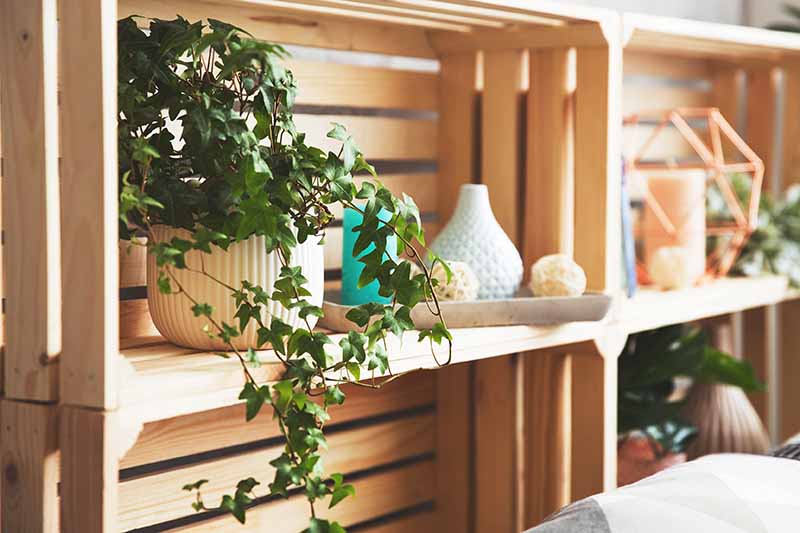
It comes in various shades of green, with triangle-shaped leaves marked by prominent veins. Nondescript blossoms are rare with indoor cultivation. Note that it is toxic to pets.
English ivy is very easy to grow, provided it never dries out or suffers from the dry air of an overheated room.
A vigorous grower, it’s best to start your ivy in a large container, otherwise you may find yourself repotting often. To keep it more compact, you can snip off trailers and place them in water to propagate new plants or discard them.
English ivy grows best in organically-rich soil that is evenly moist. Fertilize and water well during the growing season. In winter, water needs are reduced.
You can find English ivy available from Nature Hills Nursery in four-inch or #1 containers.
Find all you need to know to grow English ivy indoors here.
11. False Aralia
False aralia (Plerandra elegantissima) is a compact, shrub-like rainforest tree that grows very slowly. Its leaves are narrow and toothed.
The tops are glossy green, or variegated green with white margins, with copper-green undersides. It’s nontoxic to pets.
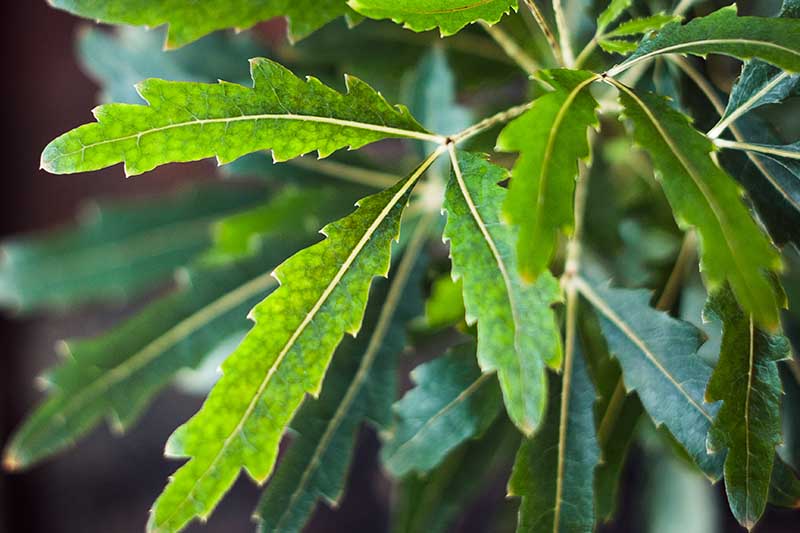
In the first few years, you’ll enjoy a tabletop “mini-tree,” but be prepared for gradual growth of up to eight feet over its lifetime.
False aralia prefers organically-rich, evenly moist soil, but it’s quite forgiving – so it won’t fail the minute you forget to water. It will wilt to let you know it’s thirsty before bouncing back.
Fertilize during the growing season. Fruits and flowers seldom appear with indoor cultivation, but these are far from showy, and the foliage is the main draw of this plant. It’s also well-suited to propagation so you can root cuttings to share with friends!
False aralia is available from Plant Vine via Amazon in three-gallon pots.
Learn how to grow and care for false aralia in our guide.
12. Fiddle-Leaf Fig
Let’s be clear at the outset that while very attractive, you’ve got to love a challenge to grow this finicky foliage, especially in low light.
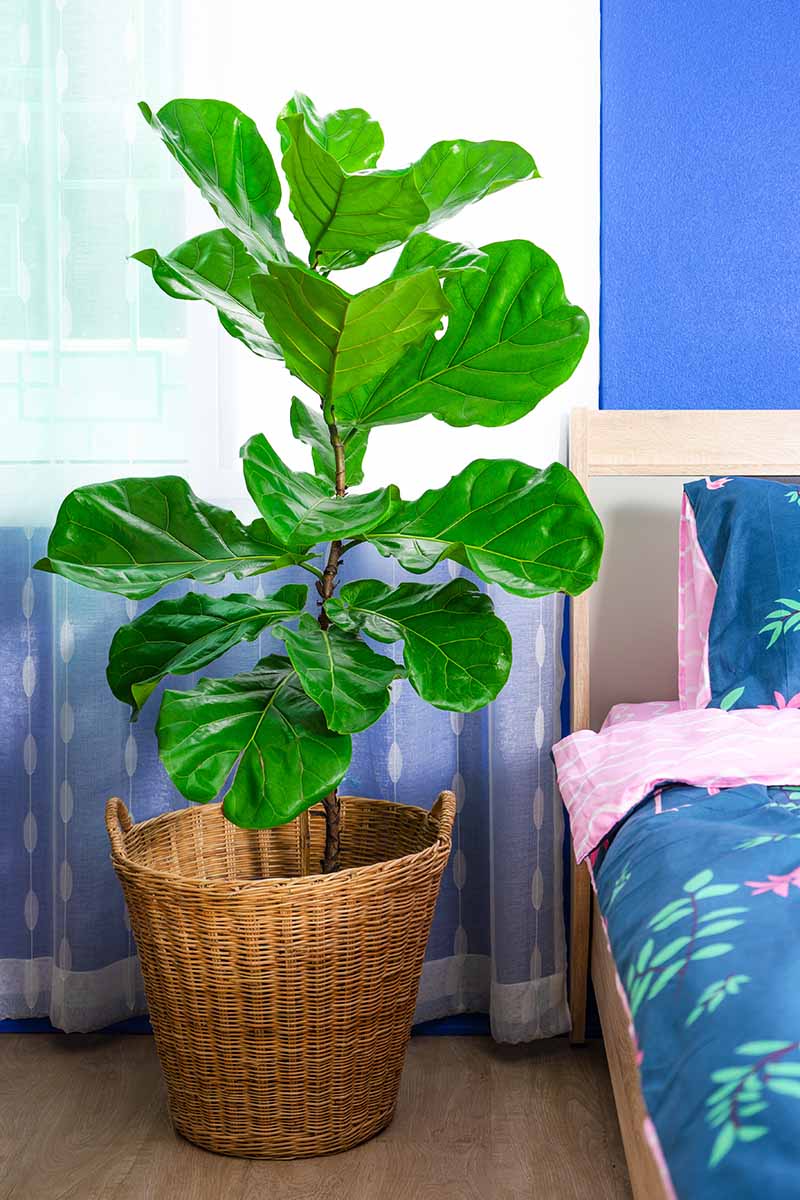
When grown indoors, the fiddle-leaf fig (Ficus lyrata) may become tree-like, but is unlikely to bloom or set fruit. It’s star attractions are the rounded, glossy, rippled dark green or variegated leaves.
It thrives in an organically-rich potting medium that is moisture-retentive and drains well, and may grow between six and 10 feet in temperatures that don’t go below 55 or exceed 85°F.
Disruptions often cause shock, resulting in slower growth and even wilting or leaf drop.
Drafts, extreme temperature fluctuations, changing locations, repotting, and even watering may cause varying degrees of stress from which your plant will need time to recover.
Best in bright indirect light, the fiddle-leaf fig can also tolerate low light conditions.
Rotating the pot occasionally is often recommended, so different parts of the plant will be exposed to what light there is – but try to avoid disturbing your fig too often, as these plants are also prone to leaf drop.
Use a pot that drains well, and if you don’t already have one, invest in a moisture meter, aka a hygrometer.
Water when the top two inches of soil are completely dry, and take care to avoid oversaturation that can lead to rotting. Err on the side of too dry, rather than too wet. If you see browning edges on the leaves, you’ll know you’re not providing enough moisture.
The best way to water a fiddle-leaf is to set the entire pot in a tub with a few inches of water, and let it soak up what it needs for about an hour. For heavy specimens, water over the soil, not the leaves.
Be sure to allow the soil to drain completely after watering and pour out any standing water from a drip-catching saucer.
Moisture dries out slower during winter dormancy, so you’ll need to water infrequently. Dust the leaves occasionally, but avoid wetting them.
Fertilize regularly with a liquid houseplant food or slow-release granular product formulated for ficuses, per package instructions.
You can find fiddle-leaf fig plants in a variety of sizes available from FastGrowingTrees.com.
Note that this species is toxic to pets, and the sap may cause skin reactions in sensitive people.
We share all the best tips for growing your own fiddle-leaf fig in our guide.
13. Fishtail Palm
Topping out at four feet tall, the unpretentious shredded edge of the fishtail palm’s foliage makes it the perfect shabby-chic accent.
However, beware that while most tropical plants won’t produce flowers and fruit when grown indoors, the red berries of the fishtail palm are highly toxic to people and pets if ingested, and irritating to the skin on contact.
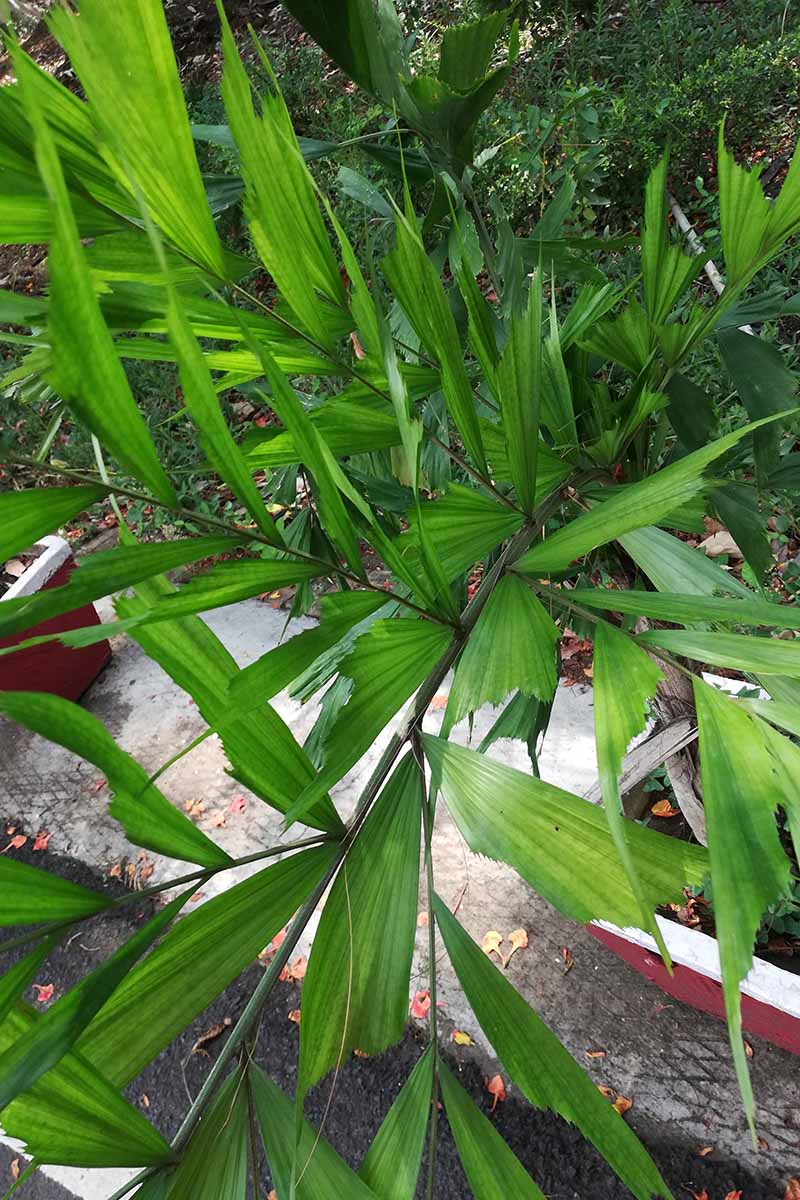
Consider Caryota mitis only if you have no children or pets in the house, on the off chance that it produces fruit.
The fishtail palm always needs to have moist roots, and regular watering is a must. You’ll water most during the growing season, and less in the winter. Summer is the time to fertilize.
Propagation of this lush tropical specimen may be accomplished via little rootlets called “suckers.” These may be snipped away to make new plants.
You can find two- to three-feet and three- to four-feet-tall fishtail palms available from Fast Growing Trees.
Check out our guide to learn how to grow and care for fishtail palms.
14. Grape Ivy
A container of creeping grape ivy (Cissus alata) perched on a fireplace mantle will rapidly make its way across the top and down the sides, softening hard edges with its profusion of triangular green leaves.

Grape ivy grows vigorously in moist, porous, organically-rich soil. Allow pots to dry out completely before watering in low-light conditions. An occasional misting will help to maintain adequate humidity.
During the growing season, fertilize and water diligently. Less water is needed in winter. Nondescript blossoms and berries may appear at this time but they are uncommon when grown indoors.
You can prune grape ivy to maintain a compact shape, or let new shoots grow and spread. Snipping new growth stimulates the production of even more stems.
To propagate new plants, simply place snipped stems in water until roots form, then transfer to a container full of potting medium.

For another design idea, grow grape ivy in pots suspended from hooks in the ceiling, where the trailing tendrils can bring motion into the static, dim areas of your home.
Grape ivy is available from the Plant Farm Store via Amazon in four-inch pots. It is nontoxic to pets.
15. Parlor Palm
This slow-growing palm (Chamaedorea elegans) tops out at four feet tall. Its slender stems and arching, feathery leaves resemble those of bamboo, for a tropical interior vibe. This species is nontoxic to pets.
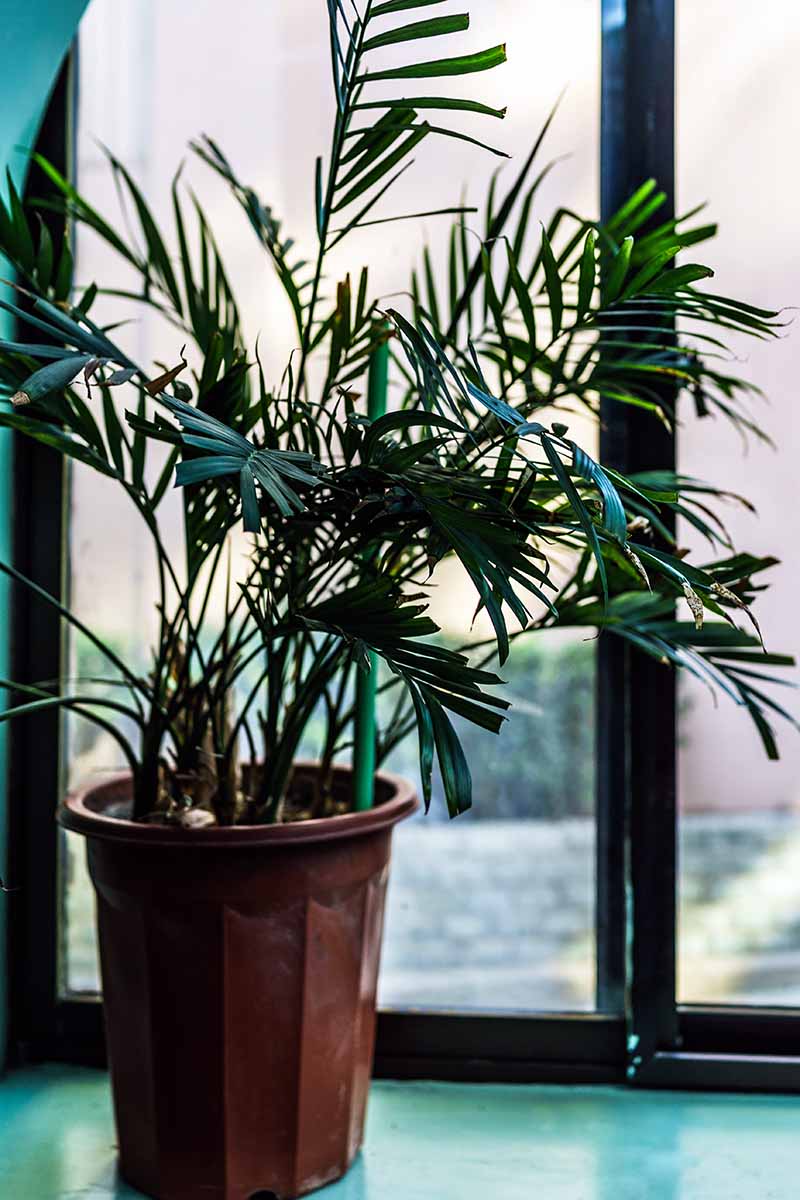
Parlor palm grows best in organically-rich soil that drains well. It dislikes dry air, so supplement your home’s humidity by misting the leaves occasionally.
Water well during the growing season to keep the soil moist, and if desired, fertilize monthly with a liquid houseplant food.
In the winter you’ll need to water less frequently. Yellow flowers may sometimes appear with indoor cultivation, though this is not likely in low light.
There’s no pruning needed with the parlor palm, but if you’d like to remove a frond, snip it all the way down at the base of the stem.
You can divide larger specimens to maintain their shape or create new plants. Repot only when roots protrude from the drainage holes in the bottom.
You can find parlor palms in six-inch pots available from Fast Growing Trees.
Learn how to grow and care for parlor palm in our guide.
16. Peace Lily
A finicky beauty, the peace lily (Spathiphyllum spp.) boasts dark green foliage that helps to brighten up dimly lit areas. But don’t expect a profusion of the Jack-in-the-pulpit-like white spathes that these plants are known for in low-light conditions.

Choose a location in a temperate room away from drafts. Use a deep pot that can comfortably accommodate the roots and that has good drainage. Fill it with an organically-rich potting medium.
Here’s the fussy part: peace lilies are sensitive to chemicals in treated municipal water, so it’s better to use filtered, or rainwater.
Water generously during the growing season, and less frequently in winter. You can let the top inch of soil dry out between waterings. Fertilize monthly during the spring and summer.
Discolored leaves may be the result of under- or over-watering, or a lack of humidity. Peace lilies will wilt the first time you forget to water, and can quickly spiral downward and die, so don’t forget!
If it’s kept well watered and healthy, your lily may become pot-bound and require repotting every year or so. The rhizomes may be separated easily for thinning out and propagating new plants.
Peace lily is available from Fast Growing Trees in a six-inch or three-gallon pot. Peace lilies are toxic to pets.
Learn to grow peace lilies here.
17. Peperomia
From a collection that you can display in a shallow receptacle on the coffee table to a series of pots arranged on your entertainment unit shelves, the small scale and wide variety of available Peperomia species opens up a world of possibilities.
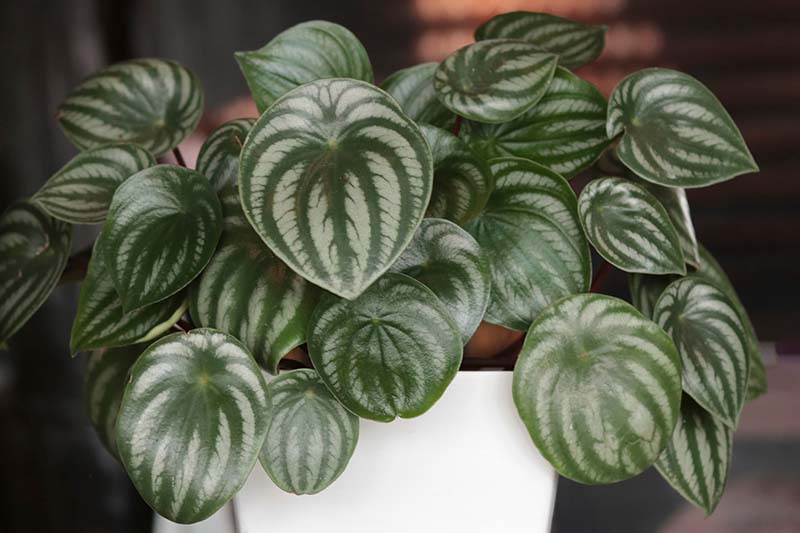
These low-profile lovelies are generally eight inches or less in height, and grow in a clumping or creeping fashion, depending upon the species.
They thrive in an organically-rich potting medium that is kept evenly moist and drains well. Water when the soil surface feels dry to the touch. Avoid overwatering, as it can cause rotting.
You can increase the humidity in your plant’s environment by misting occasionally or setting pots on a tray of wet pebbles.
Thailand peperomia plants (P. obtusifolia) are available from Home Depot in four-inch pots.
All varieties are nontoxic to people and pets.
Find out how to grow your own peperomia here.
18. Philodendron
What’s not to love about glossy green or variegated leaves shaped like hearts, lily pads, or arrowheads?
Philodendron species offer both climbing and non-climbing, aka “self-heading,”varieties. They’re a fascinating genus with species that grow in soil, attach themselves to host plants, or both.

Climbing varieties may be grown in soil or water, and may grow long enough to wrap around a room.
Fast-growing, low-maintenance, and nearly foolproof heart-leaf philodendron (P. oxycardium), not to be confused with pothos (below), is perhaps the most easily recognized of the species.
And while there are amazing stories of plants exceeding 1,000 feet in length, reducing legginess and promoting bushier growth is easily achieved by pinching back a trailing stem just above a leaf node.
As a plant matures, the leaves get larger, and yours may even surprise you with greenish blossoms, though this is rare – particularly in low light.
Humidity is conducive to lush foliar growth. Water at the soil level to maintain even moisture, and mist the foliage occasionally during the growing season.
You’ll find the pot dries out more slowly during winter dormancy, and misting is not necessary during non-growth periods.
Watch out for high-nitrogen fertilizer as your plant may grow like crazy. Choose a well-balanced liquid houseplant food instead, and apply it monthly from spring through fall.
Try training a climbing species around a rich, earthy moss pole. Direct any visible aerial roots down toward the soil, or snip them off. They’re for adhering to trees in the species’ native jungle habitat.
Heart leaf philodendron is available from Hirt’s Garden Store via Amazon in four-inch pots. Note that philodendrons are poisonous to humans and pets.
Find all you need to know to grow your own philodendron here.
19. Pothos
Also called devil’s ivy, pothos (Epipremnum aureum) is known for being easy to grow and for producing exceptionally long vines.
There are numerous types of pothos, but a feature they all share is the heart-shaped leaves on trailing vines. Imagine them wrapped around an entire room, softening the edges of stately oak bookshelves or sleek lighted curio cabinets.

The foliage may be green or green variegated with white or yellow. In low-light conditions, variegation may be less pronounced and leaves may shade to all green.
Like a philodendron, this climber is a fast-grower that’s easy to take care of, thriving equally well in soil or water. It, too, has aerial roots for climbing jungle trees.
These are also useful for training vines to grow upwards on moss poles, instead of hanging downwards.
Pothos grows best in organically rich, well-draining potting medium, and needs water when the top two inches of soil are dry.
‘Pearl and Jade’ variegated pothos in six-inch nursery pots are available from Home Depot.
Pothos is toxic to pets, and contact with sap may cause skin reactions in sensitive people.
Read more about growing pothos in our guide.
20. Snake Plant
Thick, sword-like, upright leaves that reach one to four feet tall characterize the slow-growing snake plant, aka mother-in-law’s tongue.
It is a very forgiving plant, because it’s used to a hardscrabble life in its native jungle habitat, where the soil is poor and space is scarce.
Formerly known as Sansevieria trifasciata, this plant was recently reclassified as Dracaena trifasciata. You may see either botanical name on plant tags.
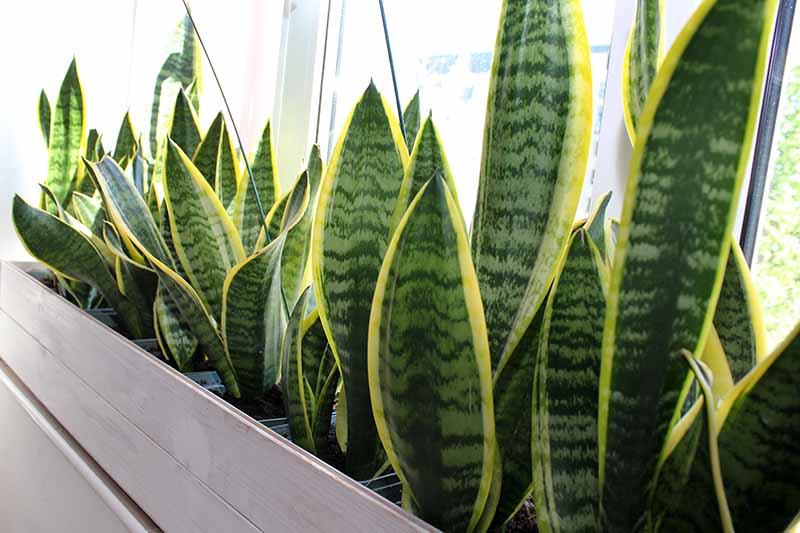
Low-maintenance and easy to grow, it has a high tolerance for very bright as well as very dim light, being rootbound in a small pot, and dry potting medium.
The best medium to grow it in is a cactus and succulent product that is formulated for exceptional drainage.
Allow the soil to dry out completely between waterings, and occasionally wipe the leaves down with a soft cloth to rid them of dust.
During winter dormancy they don’t need more than a splash of water every few weeks. Take care not to overwater as this is likely to cause rotting.
Fertilizer is not required, but if you choose to use it, dilute a liquid houseplant food to half strength and apply it in the spring or summer.
Cultivars range in color from light to dark green, white mottled, or gold edged. They do best in the 65 to 85°F range. Temperatures that are too cold may cause brown scarring.
Dark green with paler, silvery-green stripes, potted ‘Superba’ snake plants are available from Burpee.
Snake plants are toxic to pets.
Learn all about growing snake plants in our guide.
21. Spider Plant
The easy-care, fast-growing tropical spider plant (Chlorophytum comosum) has green, variegated green and white, or green and yellow leaves that grow in a clumping form, arching gracefully like spray from a water fountain.
It looks most attractive in a hanging pot.
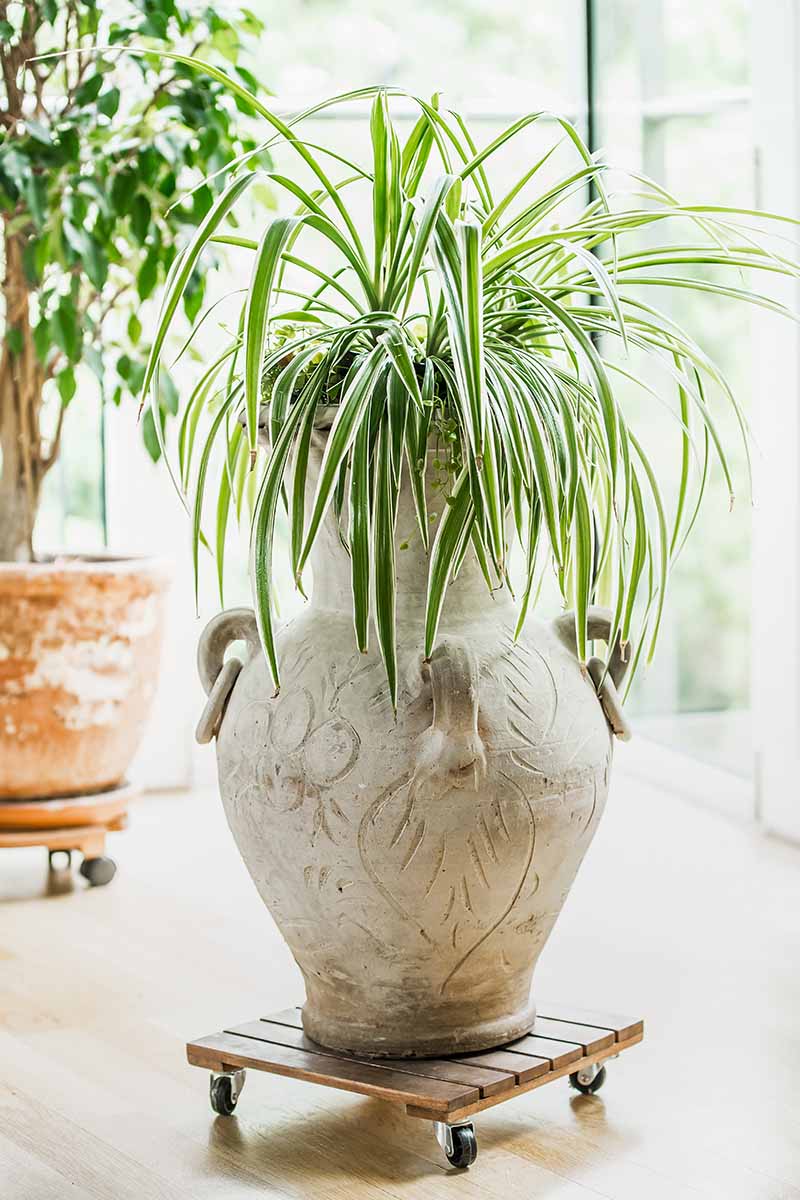
Cultural requirements include well-draining potting soil, a room temperature of 65 to 75°F, and water when the top inch of soil dries out. Provide a pot with adequate drainage and avoid oversaturation that can lead to rotting.
It’s not necessary to fertilize, as too much can burn tender leaf tips. If you choose to feed, use gentle worm compost tea. Cold drafts are another cause of browning tips, so be sure to avoid them.
Choose green cultivars for low-light placements. Variegated types do best in moderate to bright indirect light, and will shade to green in dim settings.
A unique feature is the wire-like stems of about two feet in length that descend from the foliage to sprout baby “plantlets,” aka “spiderettes.”
These are more likely to appear in brighter light conditions, and are easily snipped to root and grow in pots of their own.
Plants that fit snugly in their pots are more likely to produce plantlets, so don’t repot large plants until you see roots poking from the drainage holes, indicating that they are becoming root bound and need more space.
‘Bonnie’ is available from Hirt’s Gardens Store via Amazon in four-inch pots. It has fun curly leaves and grows more slowly than some other spiders.
Spider plants are nontoxic to pets.
Read our guide for the best tips to get started with growing spider plants at home.
22. Swedish Ivy
The bright, glossy green leaves of Swedish ivy (Plectranthus verticillatus) have crenate, or round-toothed margins. Trailing to lengths of two to three feet, this fast grower is well-suited to hanging baskets.
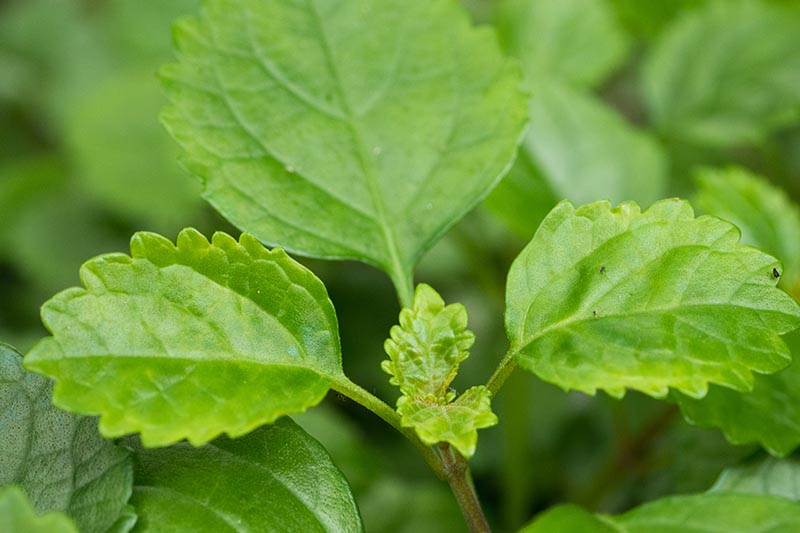
It prefers organically-rich, evenly moist potting medium that drains well, and likes to fit snugly in its pot.
Provide a temperate setting between 65 and 75°F during the day, and 60°F or above at night. It’s used to high humidity in its native tropical habitat, but tolerates typical indoor levels well.
Swedish ivy may become leggy in low light. If it is getting scraggly, pinch off the growing tip just above a leaf node at the length of your choice to promote branching growth.
Water when the top inch of soil is dry. Feed monthly with a well-balanced liquid or granular plant food diluted to half strength.

Swedish ivy is available from the Sprig & Stone Store via Amazon in a 2.25-inch pot. It is nontoxic to pets.
Learn how to grow and care for Swedish ivy in our guide.
23. Swiss Cheese Plant
Also known as monstera or split-leaf philodendron, the tropical Swiss cheese plant (Monstera deliciosa) has giant leaves that may measure 18 inches or more in length, with “fenestrations” or openings that appear as deep leaf edge serration and holes.
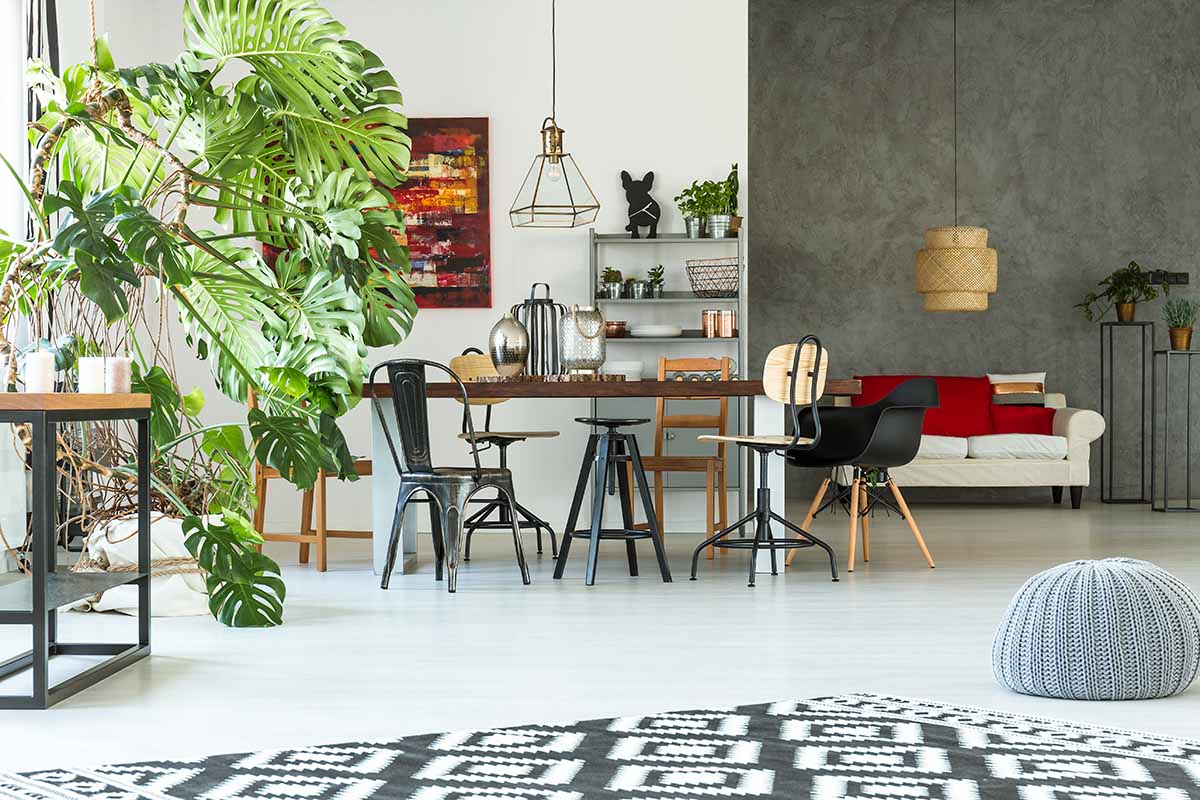
The leaves start out whole, and in low light, may remain whole. And while unlikely indoors, a mature plant may bear white, lily-like flowers followed by fruit.
This climber puts out aerial roots that readily cling to a moss pole. An overabundance of these above-soil roots may mean it’s time to repot. You can curb aggressive growth by snipping these roots off for a more compact specimen.
Choose a temperate 60 to 80°F location and prevent exposure to temperatures below 50°F. If possible, maintain ambient humidity at or above 40 percent. You can raise the moisture level by grouping plants, or misting the foliage occasionally.
Periodically wipe the leaves with a soft cloth to rid them of dust that attracts pests.
Monstera plants are available from FastGrowingTrees.com in a variety of sizes and decorative planter options.
Learn to grow your own Swiss cheese plant here.
24. Wandering Dude
Striped green and silver ovate leaves with purple undersides are a key feature of the fast-growing wandering dude (Tradescantia zebrina).
It’s also known as inch plant because the leaves are spaced one inch apart from each other, as well as spiderwort.
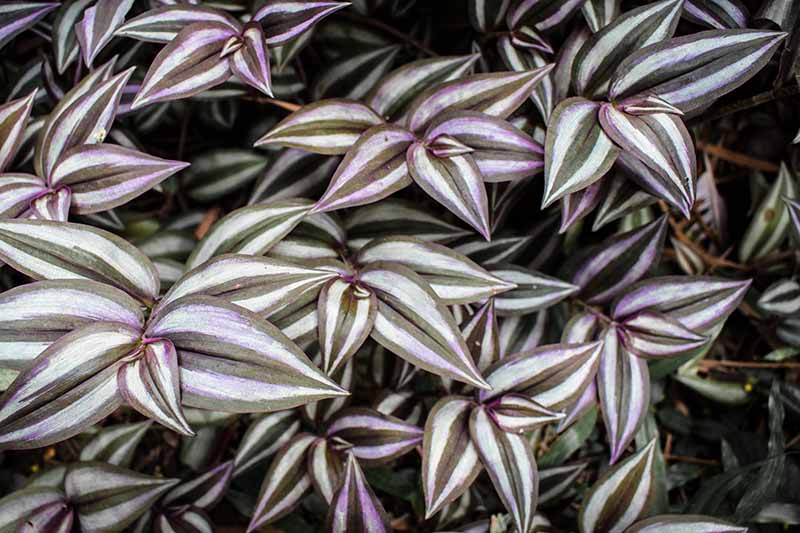
The best room temperature for this trailing beauty is between 70 and 80°F, and never lower than 50°F.
It prefers bright indirect light, where its variegated colors are the showiest, but tolerates lower light placements as well.
Cultivate in organically-rich, moisture-retentive, well-draining potting medium. Water when the top one to two inches feel dry, and avoid both letting it dry out completely, and oversaturation.
As a tropical, wandering dude loves humidity. If your home is especially dry, under 30 percent humidity, you can increase the ambient moisture around plants by grouping them together, or using a humidifier.
Misting with a spritz-bottle is an option, but beware – persistently dim and damp conditions may result in fungal growth.
Fertilize monthly during spring and summer with worm compost tea to reduce the risk of over-feeding and burning foliage, while boosting soil nutrients.
If your plant gets too leggy, pinch it back just above a leaf node to encourage lateral growth. In the spring, you can cut back up to one-third of the foliage for a rejuvenating prune, if desired.

Tradescantia zebrina is available from Shop Succulents via Amazon in a four-inch pot. It is toxic to pets and may cause a skin reaction in sensitive people.
Read our guide now to learn more about growing your own wandering dude.
25. ZZ Plant
Tropical ZZ plant (Zamioculcas zamiifolia) is tough as nails, with pairs of leathery, elliptical green leaves and thick stems. It averages two to three feet tall indoors, but is capable of soaring to five feet.
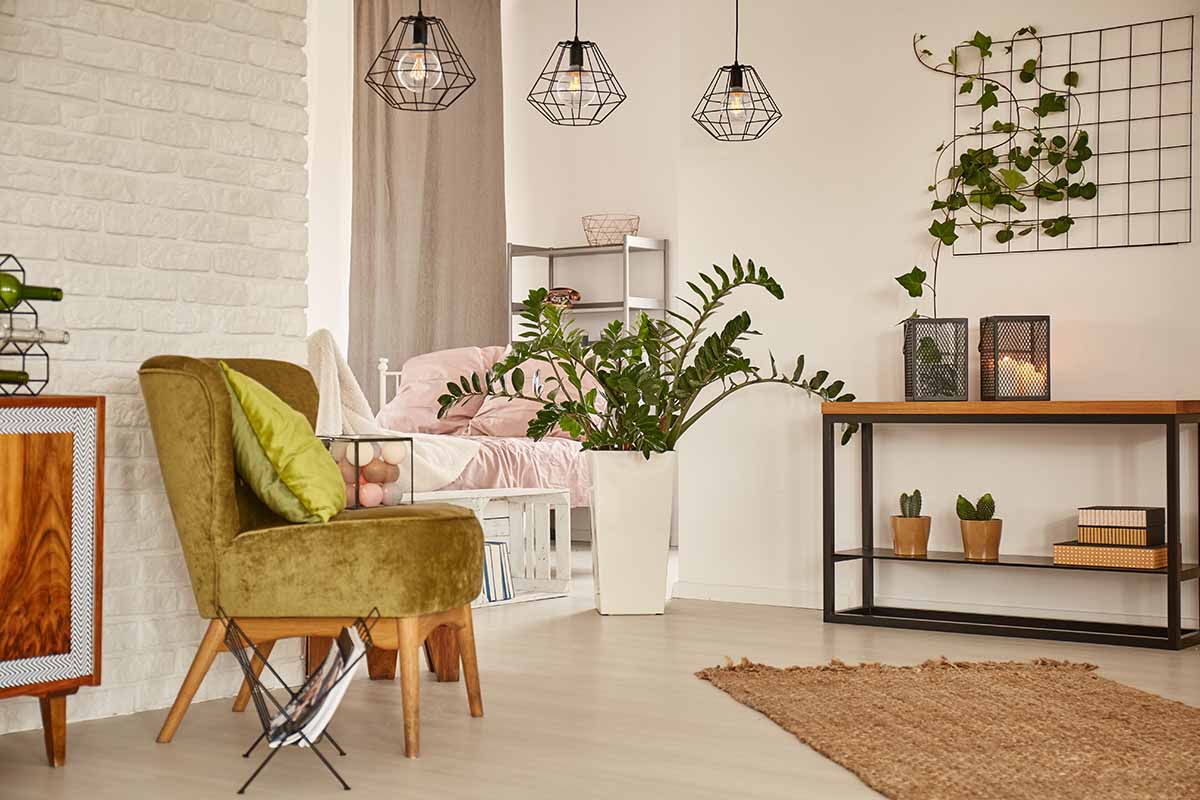
Able to store water and sustain itself through a drought, your ZZ is not going to quit on you if you occasionally forget to give it a drink. Bright indirect sunlight is the best, but ZZ performs admirably in low-light and beneath fluorescent bulbs.
You’ll need a temperate location in the range of 60 to 75°F, and always above 45°F. Avoid drafts and increase the humidity if your home is especially dry.
Use a well-draining pot and avoid oversaturation. Let the soil dry out completely before watering again. The fleshy rhizomes are built to store water, and can easily rot if they are too wet.
Low-light plants grow slowly. Prune as desired, just above a pair of leaves, for a more compact form.
Plants in six-inch, 10-inch, and three-gallon containers are available from Fast Growing Trees.
The ZZ plant is toxic to pets.
Learn to grow your own ZZ plant now.
No Sun, No Problem
With 25 attractive options from which to choose, you are well on your way to establishing a low-light arrangement of greenery that will bring your indoor decor to life.
And you’re sure to enjoy reaping the added benefit of tending to plants as a relaxing stress-buster at the end of a busy day.
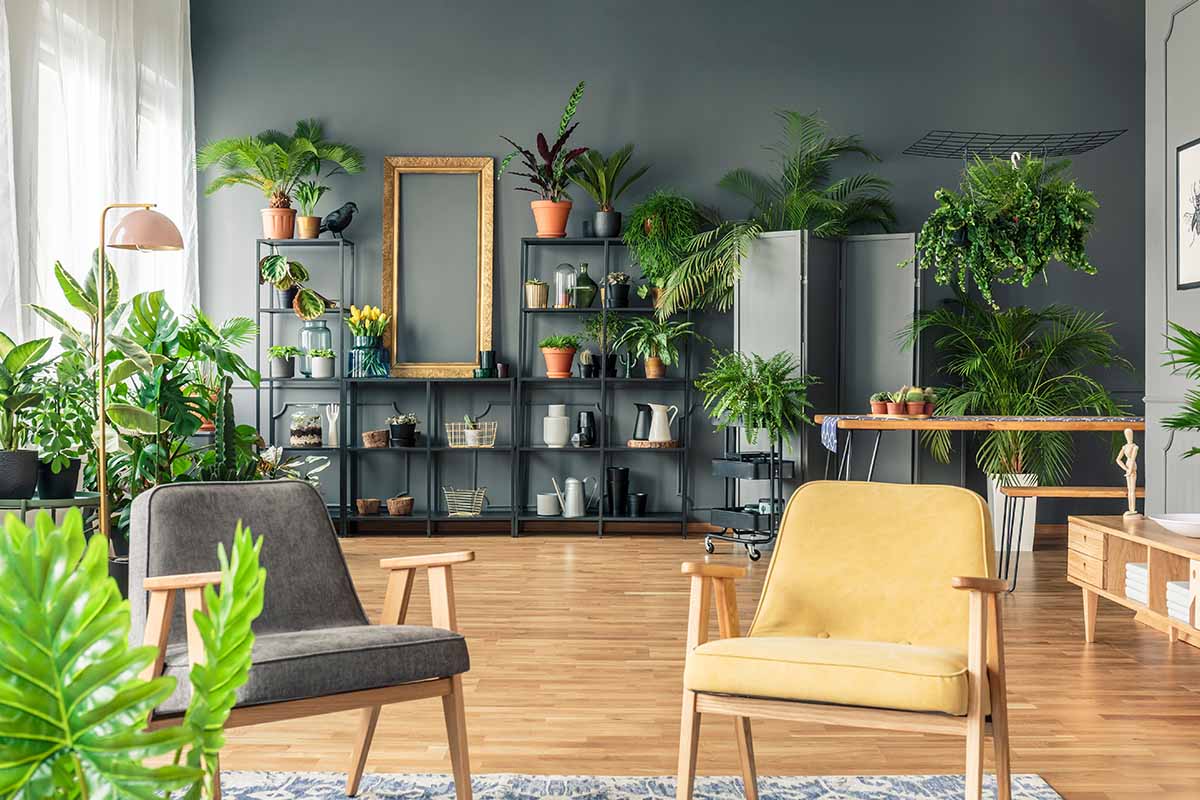
When selecting plants, remember that green varieties yield the best results under low-light conditions. You can try more colorful cultivars, but they may fail to produce a showy display in dim rooms.
Flowering, a rare occurrence for some of the options described above, is unlikely in low light as well.
If you live in a temperate zone, you can move your low-light houseplants outdoors for the summer. This is a great rejuvenator that restores their vibrant colors and boosts their overall health.
Continue to monitor their water needs, avoid both under- and oversaturation, and maintain your feeding regimen.
In late summer, before the nights dip below 50°F, choose a clear morning and spray all of the foliage generously with neem oil.
Then water, without wetting the leaves, until it runs out the bottom, and repeat. Let the plants dry through the day before bringing them indoors for the fall, winter, and spring.
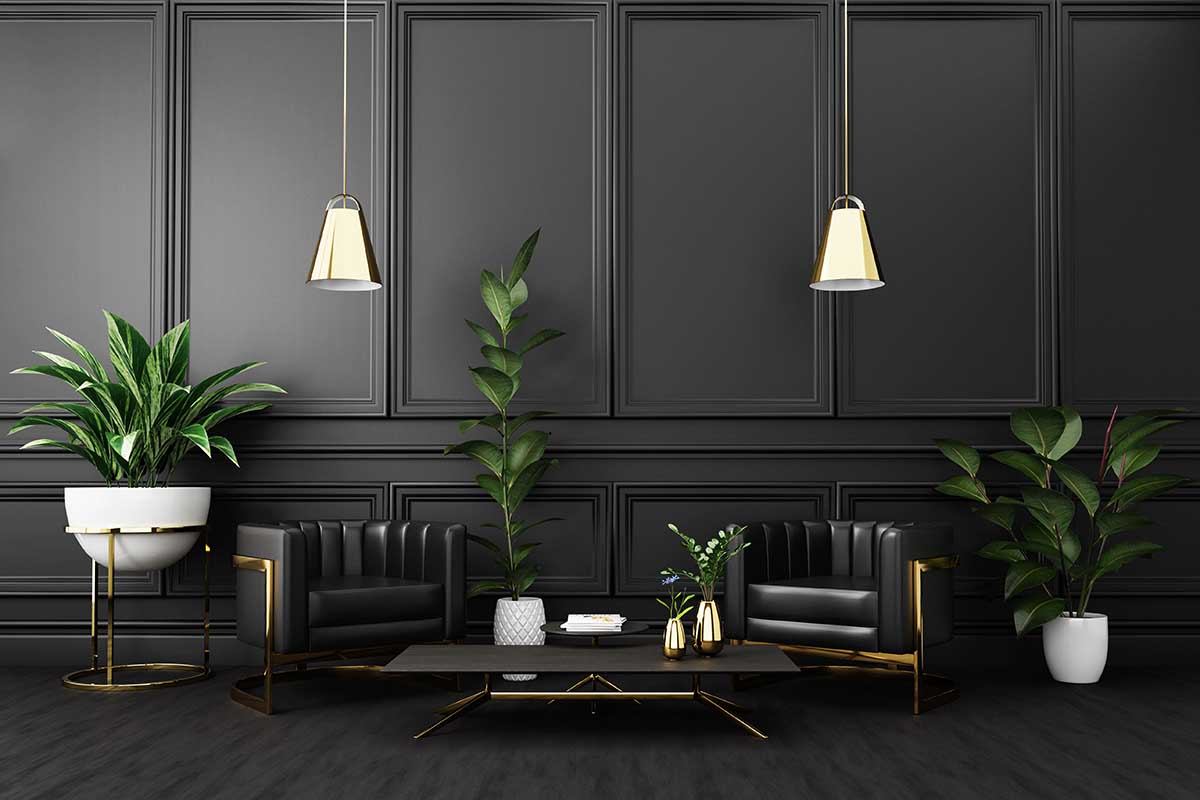
Here are five tips to review before I leave you to start shopping for exciting new plants that are going to liven up even the dimmest areas of your home:
- Use pots that drain well to prevent excess moisture buildup, a leading cause of pest and disease infestation.
- Water sparingly in winter, when plants are generally at rest.
- Always water before fertilizing to avoid burning foliage and roots. And if you see a white, salt-like mineral buildup on the soil surface, foliage, and pot, flush the pot with water, empty and rinse drip pans, switch to distilled water, and don’t wet the leaves.
- Avoiding wetting the foliage of low-light plants not only helps to reduce mineral buildup, it reduces the risk of fungal infection as well.
- Keep the leaves of your new favorites clean and shiny by wiping them gently with a soft cloth every few months.
For further information on a host of easy-to-grow options, you might enjoy Tovah Martin’s warm and witty book, “The Indestructible Houseplant: 200 Beautiful Plants that Everyone Can Grow,” available from Amazon.

Now it’s your turn to grow plants in areas of your home you never thought possible. Dress your decor up with statuesque palms or take a casual approach with playful vines – it’s totally up to you!
Share photos of your lush indoor decor with us in the comments below, and feel free to share any questions or suggestions you may have.
If you enjoyed this article, you may like to read the following guides to houseplants next:
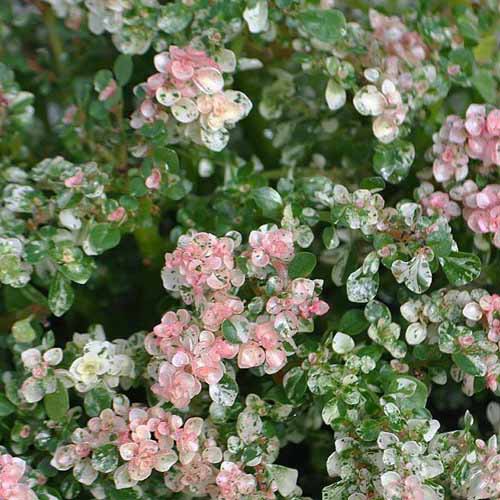


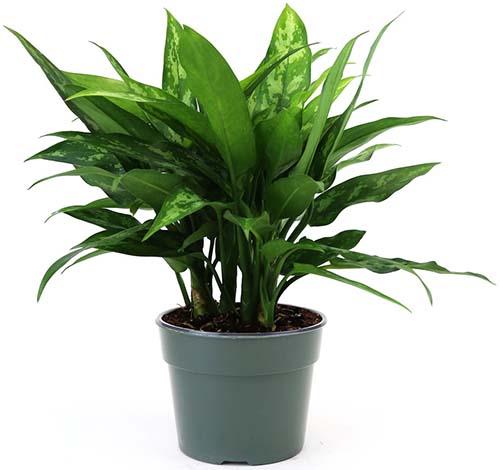

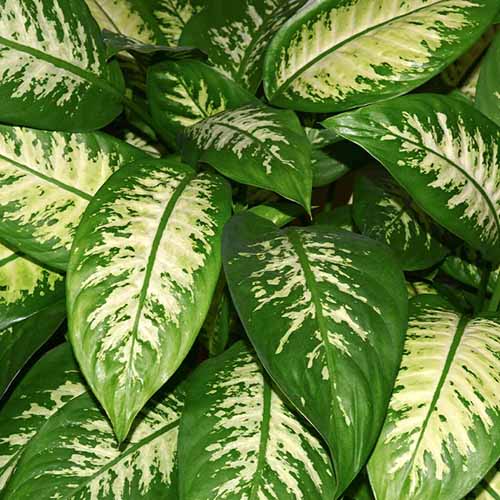

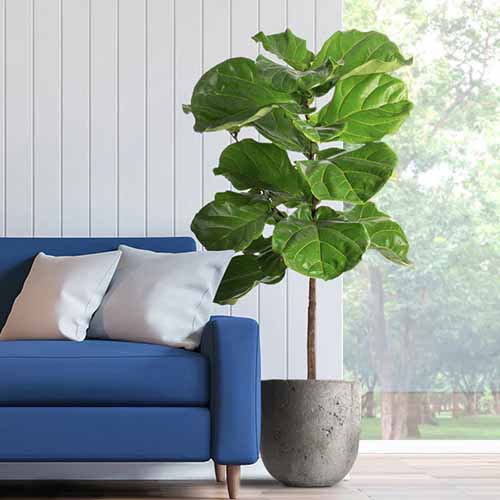
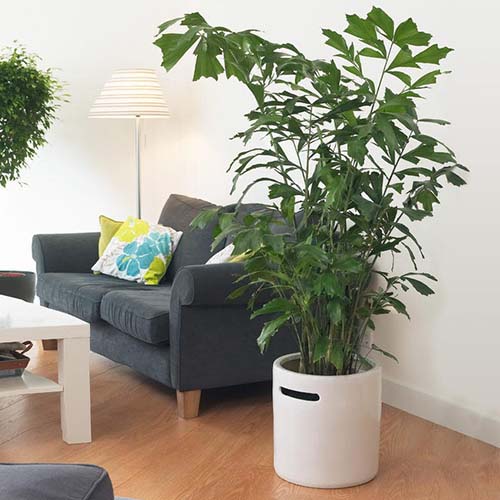

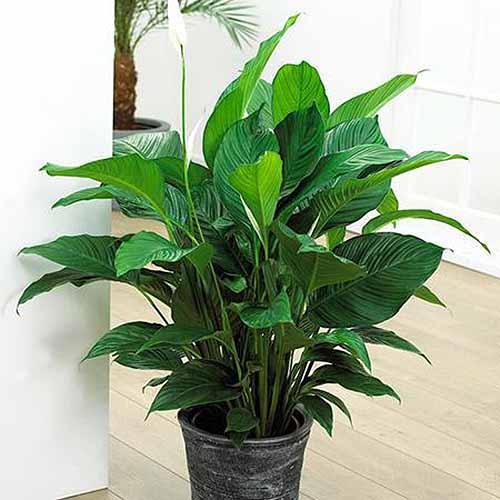
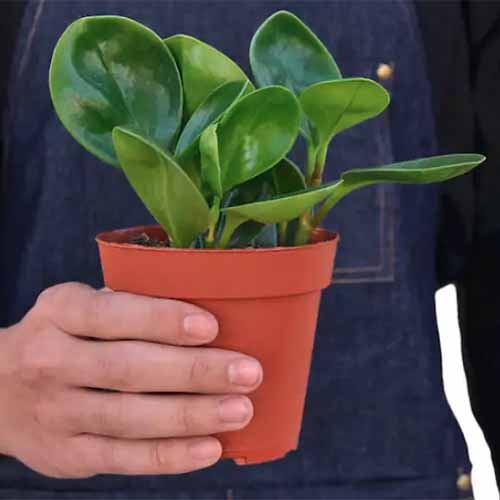
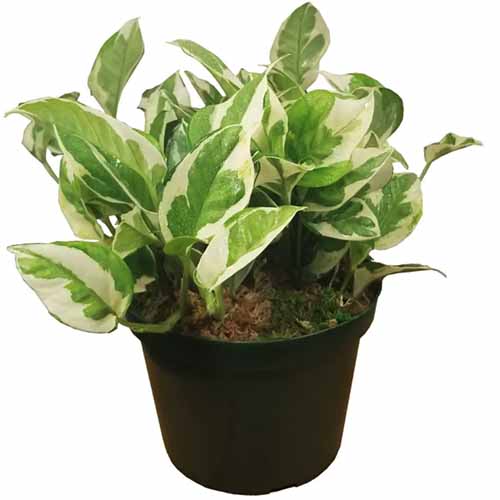
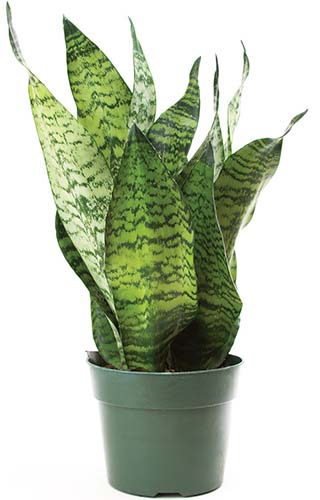
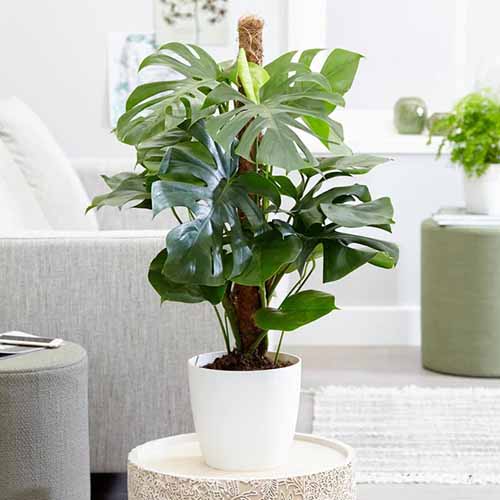

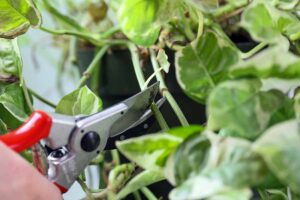
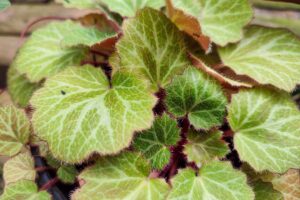
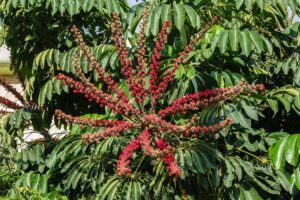
Loved it!